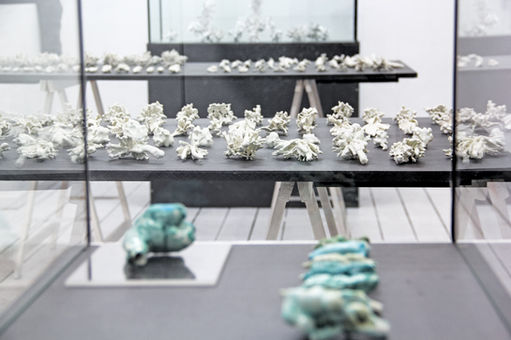SOMEONE DIED
WORKS


EXHIBITION VIEWS

DESCRIPTION
Throughout history, humans have been analysing nature, trying to find the quintessence of life: immortality. Scientists search for the ‘theory of everything’, philosophers search for ‘absolute truth’, religious followers search for God, alchemists search for the philosopher’s stone and everyone searches for ‘true love’. What all human searching has in common is its dissecting nature. We take things apart in order to understand them, destroy them in order to understand their vitality, use death to achieve immortality.
Franzen’s project is motivated by the notion that humans cannot appreciate or love something without destroying it in the process. To demonstrate this, Franzen chose a selection of cuttings from plants and flowers, which he then cast - some in porcelain and others in gold.
The porcelain was heated to 1250 degrees Celsius, so that it could harden and become a strong material that encapsulated the plant’s life. The results are extremely delicate, white sculptures in the exact form of the plants and flowers that were used to mould them. These sculptures still, and will have forever, the ashes of their form-givers inside them. All the sculptures are presented in white monochromatic form, their beauty preserved for posterity but only at the cost of what made them so exquisite in the first place: their vitality.
Throughout history, humans have been analysing nature, trying to find the quintessence of life: immortality. Scientists search for the ‘theory of everything’, philosophers search for ‘absolute truth’, religious followers search for God, alchemists search for the philosopher’s stone and everyone searches for ‘true love’. What all human searching has in common is its dissecting nature. We take things apart in order to understand them, destroy them in order to understand their vitality, use death to achieve immortality.
Franzen’s project is motivated by the notion that humans cannot appreciate or love something without destroying it in the process. To demonstrate this, Franzen chose a selection of cuttings from plants and flowers, which he then cast - some in porcelain and others in gold.
The porcelain was heated to 1250 degrees Celsius, so that it could harden and become a strong material that encapsulated the plant’s life. The results are extremely delicate, white sculptures in the exact form of the plants and flowers that were used to mould them. These sculptures still, and will have forever, the ashes of their form-givers inside them. All the sculptures are presented in white monochromatic form, their beauty preserved for posterity but only at the cost of what made them so exquisite in the first place: their vitality.
Franzen perpetuates uniqueness and eternalizes beauty, whilst demonstrating that such an act exists at the cost of suffocating and destroying; by reducing what was once a beautiful, living entity to ash. It is ultimately an allegory for the mortality of humanity and our desire, as a result of the former, to achieve infinitude.
Franzen has considered that porcelain is one of the longest lasting man made materials, found in artefacts from centuries ago, yet at the same time so fragile. To drop it is to see it shatter; his choice of material makes a direct connection between the mortality of the beautiful plants, the immortality of porcelain, and the beautiful fragility of both.
Someone Died is displayed as a series of small white sculptures, which lie side by side in the vitrine, evoking the idea of corpses. Such imagery portrayed by Franzen is reminiscent of scientific finds, conserved and put on display for future scholars. Mankind investigates natural order to find the principles of life. But to strive for immortality while killing everything touched is arguably paradox, if not insane.
Franzen’s pieces capture the intricate dynamic between death, nature and the quest for immortality, in a unique collection of porcelain and gold sculptures.
Franzen perpetuates uniqueness and eternalizes beauty, whilst demonstrating that such an act exists at the cost of suffocating and destroying; by reducing what was once a beautiful, living entity to ash. It is ultimately an allegory for the mortality of humanity and our desire, as a result of the former, to achieve infinitude.
Franzen has considered that porcelain is one of the longest lasting man made materials, found in artefacts from centuries ago, yet at the same time so fragile. To drop it is to see it shatter; his choice of material makes a direct connection between the mortality of the beautiful plants, the immortality of porcelain, and the beautiful fragility of both.
Someone Died is displayed as a series of small white sculptures, which lie side by side in the vitrine, evoking the idea of corpses. Such imagery portrayed by Franzen is reminiscent of scientific finds, conserved and put on display for future scholars. Mankind investigates natural order to find the principles of life. But to strive for immortality while killing everything touched is arguably paradox, if not insane.
Franzen’s pieces capture the intricate dynamic between death, nature and the quest for immortality, in a unique collection of porcelain and gold sculptures.





































































